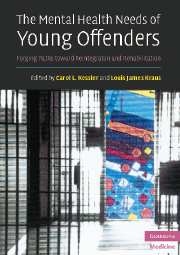Book contents
- Frontmatter
- Contents
- List of contributors
- Foreword
- Acknowledgments
- 1 An overview of child and adolescent mental health needs in the juvenile justice system
- 2 Psychiatric disorders of youth in detention
- 3 Disproportionate minority confinement
- 4 Police interrogation of youth
- 5 Assessing children's competence to stand trial and to waive Miranda rights: new directions for legal and medical decision-making in juvenile courts
- 6 The etiology of antisocial behavior: biopsychosocial risk factors across development
- 7 Substance abuse in youth offenders
- 8 Suicide and delinquent adolescents
- 9 Juvenile sex offenders
- 10 Educational needs of youth in the juvenile justice system
- 11 Science and the juvenile death penalty
- 12 Medical issues regarding incarcerated adolescents
- 13 Mental health screening and assessment in juvenile justice
- 14 Psychological testing in juvenile justice settings
- 15 Psychopharmacology and juvenile delinquency
- 16 Evidence-based treatment for justice-involved youth
- 17 Community alternatives to incarceration
- 18 Innovative problem-solving court models for justice-involved youth
- 19 Ethical issues of youthful offenders: confidentiality; right to receive and to refuse treatment; seclusion and restraint
- 20 Post-adjudicatory assessment of youth
- Index
- References
6 - The etiology of antisocial behavior: biopsychosocial risk factors across development
Published online by Cambridge University Press: 11 August 2009
- Frontmatter
- Contents
- List of contributors
- Foreword
- Acknowledgments
- 1 An overview of child and adolescent mental health needs in the juvenile justice system
- 2 Psychiatric disorders of youth in detention
- 3 Disproportionate minority confinement
- 4 Police interrogation of youth
- 5 Assessing children's competence to stand trial and to waive Miranda rights: new directions for legal and medical decision-making in juvenile courts
- 6 The etiology of antisocial behavior: biopsychosocial risk factors across development
- 7 Substance abuse in youth offenders
- 8 Suicide and delinquent adolescents
- 9 Juvenile sex offenders
- 10 Educational needs of youth in the juvenile justice system
- 11 Science and the juvenile death penalty
- 12 Medical issues regarding incarcerated adolescents
- 13 Mental health screening and assessment in juvenile justice
- 14 Psychological testing in juvenile justice settings
- 15 Psychopharmacology and juvenile delinquency
- 16 Evidence-based treatment for justice-involved youth
- 17 Community alternatives to incarceration
- 18 Innovative problem-solving court models for justice-involved youth
- 19 Ethical issues of youthful offenders: confidentiality; right to receive and to refuse treatment; seclusion and restraint
- 20 Post-adjudicatory assessment of youth
- Index
- References
Summary
The criminal character was first described in 1812 by Benjamin Rush, after he consulted on a series of cases with young people who exhibited a “total perversion of moral faculties.” He speculated that in all of these cases of “innate, preternatural moral depravity, there is probably an original defective organization in those parts of the body which are occupied by the moral faculties of the mind.” For the remainder of the nineteenth century, scientific thought was devoted to understanding the inherent traits or physical defects that characterized the criminal character. At the beginning of the twentieth century, this focus of inquiry gave way to considerations of environmental influences on the development of criminal character among those working with juvenile offenders. Recognition of the importance of environmental factors was captured in the thoughts of W. Douglas Morrison (1898) who wrote that, “Unless a man has acquired criminal habits in early life it is comparatively seldom that he degenerates into an habitual criminal … Juvenile crime arises out of the adverse individual or social conditions of the juvenile offender, or out of both sets of conditions acting in combination.” The changing view of antisocial behavior in youth served as the basis for establishing the first juvenile court in Chicago in 1899, emphasizing rehabilitation instead of punishment. This directly led in 1909 to the creation of the Juvenile Psychopathic Institute, later renamed the Institute for Juvenile Research, under the direction of William Healy.
Keywords
- Type
- Chapter
- Information
- The Mental Health Needs of Young OffendersForging Paths toward Reintegration and Rehabilitation, pp. 122 - 145Publisher: Cambridge University PressPrint publication year: 2007
References
- 2
- Cited by



